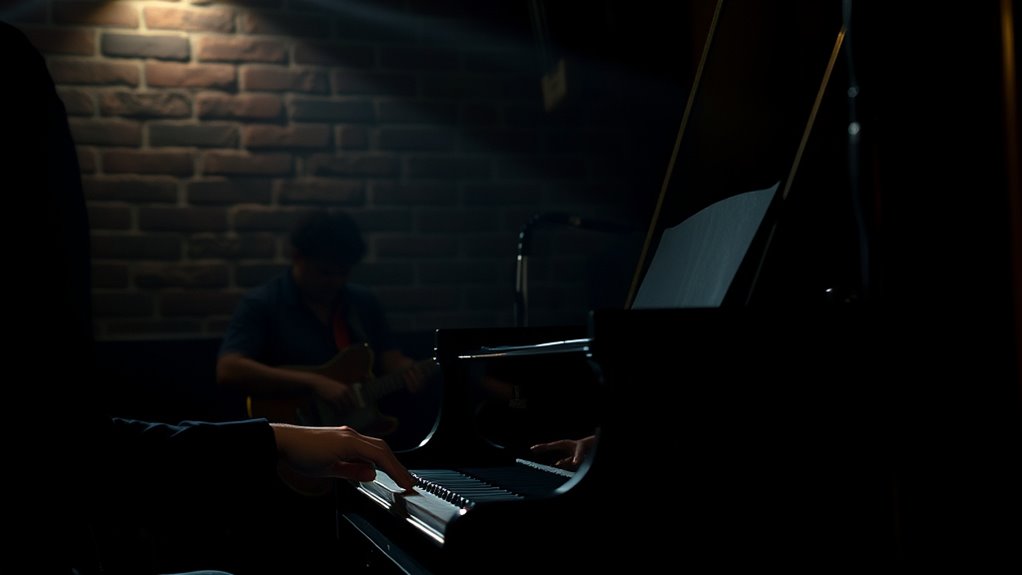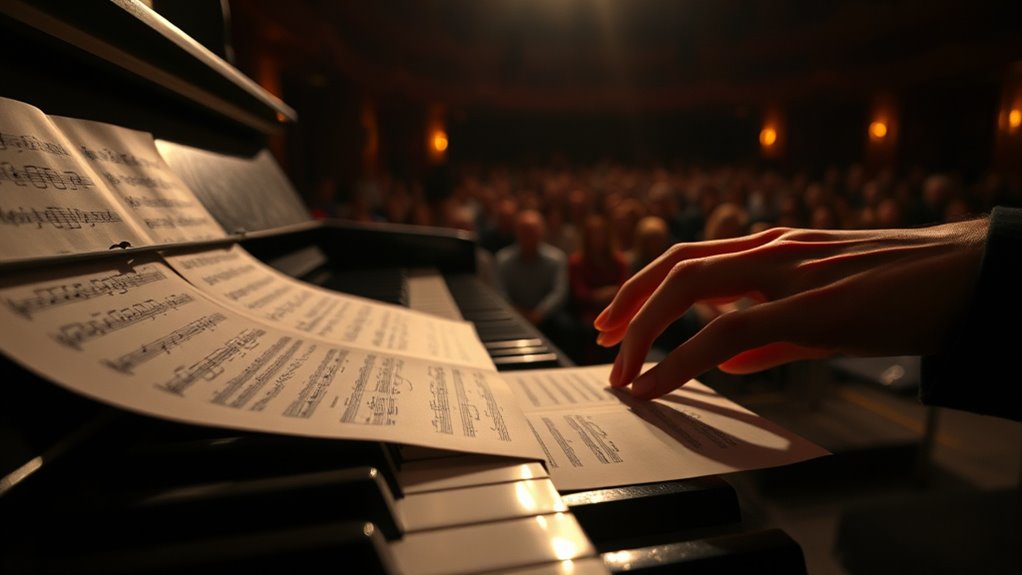To keep listeners hooked with unresolved tension, you can use harmonic ambiguity by blending dissonant chords, modal interchange, and unexpected key shifts. These techniques create emotional uncertainty and anticipation, making the music feel dynamic and compelling. By intentionally leaving progressions unresolved or ambiguous, you evoke feelings of longing, excitement, and suspense. If you want to explore how to craft these enthralling harmonic strategies that sustain listener engagement, there’s more to discover below.
Key Takeaways
- Use dissonant intervals and unresolved chords to create tension that keeps listeners anticipating resolution.
- Incorporate modal interchange and chromaticism to blur tonal centers and sustain harmonic ambiguity.
- Employ sudden key shifts and unresolved cadences to heighten emotional suspense.
- Manipulate voice leading smoothly or abruptly to guide listener expectation and surprise.
- Balance tension with strategic releases to maintain interest and emotional engagement throughout the progression.
The Foundations of Harmonic Ambiguity

Harmonic ambiguity arises when chords or progressions can be interpreted in multiple ways, creating a sense of uncertainty in how listeners perceive the music. This often involves the use of dissonant intervals, which introduce tension and a feeling of instability. Dissonant intervals challenge expectations, making the harmony sound unresolved or open to interpretation. Additionally, modal interchange plays a key role, as borrowing chords from parallel modes adds color and ambiguity, blurring the tonal center. These techniques prevent the music from feeling definitively resolved, encouraging listeners to question what they hear. By combining dissonant intervals and modal interchange, composers craft harmonic progressions that feel fluid and uncertain, keeping the listener engaged in a delicate dance of tension and openness. Furthermore, understanding how sound vibrations influence brainwave patterns can deepen our appreciation of how unresolved harmonic tension can evoke emotional responses.
Emotional Impact of Unresolved Chords

Unresolved chords evoke a powerful emotional response because they leave you in a state of anticipation and uncertainty. Dissonant intervals create tension, making you feel unsettled or enthusiastic for resolution. When you hear unresolved progressions, your mind senses that something isn’t quite finished, which heightens emotional engagement. This sense of unresolved conflict can evoke feelings of longing, hope, or even sadness, depending on the context. The ambiguity keeps you hooked, as your brain craves closure but isn’t immediately granted it. This emotional pull reinforces the sense of drama within the music, intensifying your listening experience. Unresolved chords, through dissonance and incomplete progressions, tap into deep emotional currents, making the music feel more alive, personal, and compelling. Additionally, the psychological concept of emotional regulation suggests that this tension allows listeners to process complex feelings in a safe, artistic space.
Techniques for Creating Suspense in Music

Ever wonder how composers build tension and keep listeners on the edge of their seats? One key technique is using modal mixture, shifting between major and minor modes to create unexpected emotional shifts. You can also manipulate voice leading, guiding notes smoothly or abruptly to generate suspense. To heighten tension, consider these approaches:
- Switch between parallel keys to introduce ambiguity.
- Use modal mixture to blend contrasting colors.
- Employ sparse voice leading, leaving notes hanging unresolved.
- Introduce chromaticism subtly to create a sense of instability.
- Incorporate musical harmony to enhance emotional complexity and sustain listener engagement.
Examples of Ambiguous Harmony in Popular Genres

Ambiguous harmony frequently appears in popular music, adding emotional complexity and keeping listeners engaged. Artists often use modal interchange, borrowing chords from parallel modes to create unexpected shifts in color and mood. For example, a song might switch from a major to a minor key temporarily, enhancing tension. Chromaticism also plays a vital role, with notes outside the standard scale adding richness and unpredictability. These techniques blur traditional harmonic boundaries, creating ambiguity that invites listeners to interpret the music in multiple ways. Pop ballads, jazz-influenced tracks, and even some contemporary hits employ modal interchange and chromaticism to craft unresolved, enthralling soundscapes. This harmonic ambiguity keeps the music fresh, engaging your ear and encouraging repeated listening. Additionally, composers often utilize changing Gears on a Gravel Bike to subtly shift harmonic tension within a piece, mirroring the emotional shifts created by ambiguous harmony.
Balancing Tension and Resolution for Maximum Effect

Achieving the right balance between tension and resolution is essential for creating emotionally compelling music. You can craft this balance through techniques like modal mixture and chromaticism. Imagine:
- A sudden shift from a major key to its minor counterpart, adding depth without losing familiarity.
- A hint of chromatic passing tones weaving between chords, creating subtle tension.
- An unresolved cadence that leaves listeners craving closure.
- A gradual move from dissonance to consonance, building anticipation. These techniques keep listeners engaged, as unresolved harmonic ambiguity generates emotional pull. By carefully blending modal mixture and chromaticism, you manipulate tension—either prolonging it or releasing it at just the right moment—maximizing emotional impact and ensuring your music stays memorable. Additionally, understanding relationship dynamics can help composers evoke specific emotional responses by mirroring complex interpersonal feelings through harmonic choices.
Frequently Asked Questions
How Does Harmonic Ambiguity Differ Across Musical Cultures?
When exploring how harmonic ambiguity differs across musical cultures, you see that cultural perception shapes how listeners interpret unresolved tension. In some traditions, like Western jazz, melodic nuances and unresolved harmonies create a sense of intrigue and emotional depth. Meanwhile, other cultures may prioritize clear tonal structures, perceiving ambiguity differently. Your understanding of these differences reveals how cultural context influences the emotional and aesthetic impact of harmonic ambiguity in music.
Can Unresolved Tension Influence Listener Memory or Recognition?
Unresolved tension in music is like a story left hanging, pulling you in. It definitely influences your musical perception, making certain moments more memorable. When tension isn’t resolved, your brain works harder to encode the experience, strengthening memory encoding. This lingering uncertainty keeps you engaged, enhancing recognition later. So, unresolved tension acts as a catalyst, intensifying how you remember and recognize musical pieces, keeping your mind captivated long after the music stops.
What Role Does Rhythm Play Alongside Harmonic Ambiguity?
Rhythm, along with harmonic ambiguity, plays a vital role in engaging your listeners. You can use rhythmic complexity and syncopation patterns to create a sense of unpredictability and excitement. When the rhythm complements unresolved harmonic tension, it amplifies the feeling of intrigue, keeping your audience hooked. By blending these elements, you craft a compelling musical experience that maintains interest and encourages listeners to stay engaged and attentive.
Are There Specific Instruments Better Suited for Ambiguous Harmony?
Did you know that string instruments like violins and cellos excel at creating tonal blending? When it comes to ambiguous harmony, certain instrument pairings enhance unresolved tension. Strings, with their smooth progression, add subtle nuance, making them ideal for this purpose. They allow you to craft rich, layered sounds that keep listeners intrigued, as their tonal qualities blend seamlessly, heightening harmonic ambiguity and maintaining engagement through delicate, unresolved harmonies.
How Does Harmonic Ambiguity Evolve in Contemporary Electronic Music?
In contemporary electronic music, harmonic ambiguity evolves through microtonal experimentation and modal interchange. You’ll notice artists use microtones to create subtle pitch shifts, blurring traditional harmony, while modal interchange introduces unexpected chords that challenge listeners’ expectations. This combination keeps the music engaging and unpredictable, maintaining tension and intrigue. As a result, your listening experience becomes more immersive, with unresolved harmonic tension that encourages continued exploration of the soundscape.
Conclusion
So, next time you leave your listeners hanging with that unresolved chord, remember—you’re not just teasing them; you’re masterfully keeping them hooked. Who needs resolution when you can keep the suspense alive, right? Embrace the ambiguity, play with tension, and watch your audience stay glued, forever yearning for that sweet release you’re just too clever to give. After all, why settle for closure when you can be the musical cliffhanger everyone loves?










